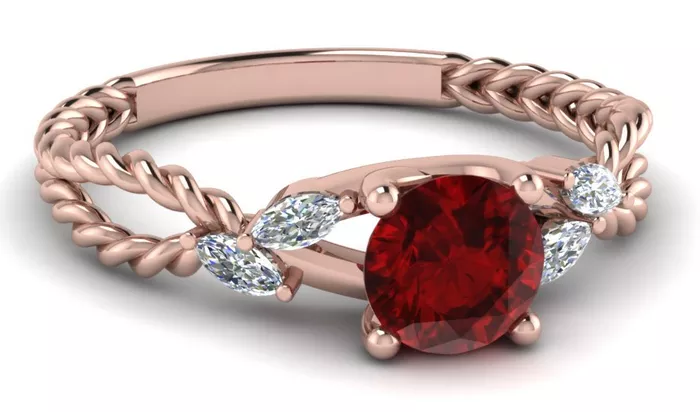Rubies, with their captivating red hues and historic significance, have been cherished for centuries. However, distinguishing a real ruby from an imitation can be challenging. Among various techniques, using a flashlight is a practical, accessible method that can yield insightful results. This article will guide you through the process of identifying a genuine ruby with the help of a simple flashlight, blending scientific principles with easy-to-follow steps.
Understanding Rubies
What Is a Ruby?
A ruby is a precious gemstone that belongs to the corundum mineral family. Its vibrant red color is primarily due to the presence of chromium. Rubies are renowned for their hardness, ranking 9 on the Mohs scale, making them second only to diamonds. Natural rubies are rare and highly valued, while synthetic rubies and various imitations are common in the market.
Common Ruby Imitations
Before diving into the flashlight test, it’s essential to recognize common ruby imitations:
Glass Imitations: Often dyed to mimic ruby’s color.
Synthetic Rubies: Lab-created rubies with the same chemical composition as natural ones but produced in a controlled environment.
Garnets and Spinels: Natural stones that can resemble rubies but have different chemical compositions and properties.
The Flashlight Test: A Step-by-Step Guide
Why Use a Flashlight?
A flashlight can help identify a ruby by revealing certain optical properties that are difficult to detect with the naked eye. This method leverages the principles of light reflection, refraction, and absorption to differentiate between real and fake rubies.
Materials Needed
A high-intensity LED flashlight
The ruby in question
A dark room or a room with dim lighting
Step 1: Inspecting Color and Clarity
Preparation: Clean the ruby to remove any dirt or fingerprints, as these can affect the results.
Initial Observation: Under normal light, observe the ruby’s color. Real rubies typically have a rich, deep red color. Synthetic rubies might appear too perfect, while glass imitations can have uneven coloration.
Clarity Check: Hold the ruby up to the light. Real rubies often contain natural inclusions (imperfections) such as rutile needles or other mineral inclusions. Completely flawless stones are usually synthetic.
Step 2: Observing Light Reflection
Dark Room Setup: Move into a dark room or dim the lights to create a controlled environment.
Flashlight Positioning: Hold the flashlight at a 45-degree angle to the ruby’s surface.
Reflection Patterns: Genuine rubies exhibit a bright red fluorescence when exposed to UV light due to their chromium content. With an LED flashlight, you may not see this directly, but the light should reflect uniformly. Glass imitations often have uneven reflection patterns, and garnets typically won’t reflect the same deep red hue.
Step 3: Checking for Double Refraction
Direct Light Exposure: Shine the flashlight directly through the ruby from one end.
Double Refraction Test: Rotate the ruby slowly. Real rubies exhibit single refraction, meaning the light passes through without splitting. In contrast, some imitations, like synthetic stones made by the flux growth method, may show double refraction where the light splits into two rays.
Step 4: Evaluating Light Absorption
Backlighting: Place the flashlight behind the ruby and observe the transmitted light.
Color Intensity: Genuine rubies will absorb certain wavelengths of light, resulting in a rich, saturated red color. Imitations like glass might appear paler or show different colors due to the presence of other materials.
See Also: Unheated VS Heated Ruby
Complementary Tests for Confirmation
While the flashlight test is a valuable initial screening tool, combining it with other methods enhances accuracy.
Magnification
Using a jeweler’s loupe or a microscope, inspect the ruby for inclusions and growth patterns. Natural rubies typically have inclusions that resemble fingerprint-like patterns, while synthetic rubies might display curved striae (growth lines).
Specific Gravity Test
Rubies have a specific gravity (density) of about 4.00. By comparing the weight of the ruby to an equal volume of water, you can determine its specific gravity. This method requires precision but can confirm the ruby’s authenticity.
Thermal Conductivity
Real rubies are excellent conductors of heat. Using a thermal conductivity probe (diamond tester set to corundum), you can test how quickly the stone conducts heat. This method helps differentiate rubies from glass and other less thermally conductive materials.
Conclusion
Identifying a genuine ruby involves a combination of keen observation, scientific understanding, and practical tools. Using a flashlight is a straightforward, effective way to examine the optical properties of a ruby. By assessing color, clarity, light reflection, refraction, and absorption, you can gather valuable clues about the stone’s authenticity.
However, remember that while the flashlight test is informative, it is not foolproof. For a definitive identification, consider consulting with a professional gemologist who can conduct advanced tests and provide a certified evaluation. Whether you’re a gemstone enthusiast or a cautious buyer, understanding these principles equips you with the knowledge to appreciate and identify the true beauty of a ruby.


